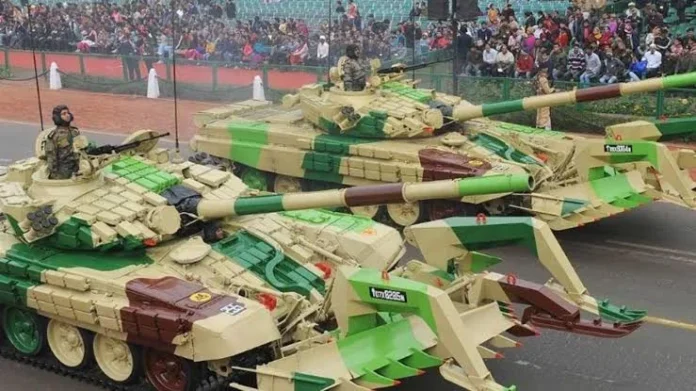New Delhi: Several Russian weapon parts stand out in India’s new list of 107 defence items published recently that will attract a phased import ban between December 2022 and December 2028, with the indigenisation drive covering warships, helicopters, tanks, infantry combat vehicles, missiles, ammunition and radars, media reports said quoting sources.
The list, a fresh push to self-reliance in defence, has been released by the defence ministry at a time when the global backlash against Russia over its Ukraine invasion has raised questions about the fate of new projects with that country, procurement of spares for existing Russian-origin weapons, and maintenance and servicing of legacy equipment operated by the three services.
The list includes sub-systems that India imports from Russia for weapons and platforms including T-90 and T-72 tanks, BMP-II infantry combat vehicles, warships and submarines, and anti-tank missiles.
“These 107 strategically important line replacement units (LRUs)/sub-systems will be indigenised in the coming years and will only be procured from Indian industry after the timelines indicated against each of them in the list,” the defence ministry said in a statement.
These components are currently imported by defence public sector undertakings (DPSUs) such as Hindustan Aeronautics Limited, Bharat Electronics Limited, Bharat Dynamics Limited, several public shipyards, Bharat Earth Movers Limited, Advanced Weapons and Equipment India Limited, and Munitions India Limited.
The items that are sought be made in the country over the next six years are required for the advanced light helicopter, the light combat helicopter, the light utility helicopter, a variety of warships, tanks, electronic warfare systems, Astra beyond visual range air-to-air missiles, Konkurs-M anti-tank missiles, armoured recovery vehicles, smart ammunition, 70mm rockets, bombs and drone-delivered ammunition.
The government has specified the deadlines for the proposed indigenisation. For instance, the 23 components (in the list) for tanks and infantry combat vehicles have to be indigenised in phases by December 2025 and the 22 LRUs/sub-systems for different types of helicopters by December 2027.
The helicopter systems that will come under the import ban include the electronic warfare suite, ground proximity warning system, active vibration control system, helmet-mounted display system, health and usage monitoring system, directional infrared countermeasures and emergency locator transmitter system.
“DPSUs will offer these identified LRUs/sub-systems for industry-led design and development. This will be a great opportunity for the Indian industry to get integrated in the supply chains of manufacturing major defence platforms,” the statement said.
The indigenous development of these items will bolster the economy, reduce the import dependence of DPSUs, help harness the design capabilities of the domestic defence industry, and position India as a design leader in these technologies, it added.
“The likely disruption of supply chains in view of the present Russia-Ukraine conflict can provide a golden opportunity to the domestic defence industry to indigenise critical components. This list reiterates the government’s focus on self-reliance in defence,” said Air Vice-Marshal Anil Golani (Retd), additional director general, Centre for Air Power Studies.
To be sure, the new list comes on the back of a positive indigenisation list of 2,851 sub-systems, assemblies, sub-assemblies and components notified by the ministry’s department of defence production last December. It has fewer but more complex items than the ones in the older list, the officials said.
The developments following the Russia-Ukraine war have underlined the need for achieving self-reliance in defence. Army chief General Manoj Mukund Naravane earlier said the biggest lesson from the Ukraine crisis was that India has to be ready to fight future wars with indigenous weapons.
The complications stemming from the wide-ranging sanctions slapped on Russia by the US and its allies could pose challenges for the India-Russia defence relationship, put India’s military preparedness to the test and assign new urgency to reduce dependence on imported military hardware to stay battle-ready.
Russian-origin equipment forms the bedrock of India’s military capabilities and includes fighter jets, transport planes, helicopters, warships, submarines, tanks, infantry combat vehicles, multi-rocket systems, rifles and even shoulder-fired missiles.
While it is still unclear how the new sanctions on Russia could play out and the problems they could create for the armed forces in the short and long term, the possible impact of the new developments on India’s military preparedness and the serviceability of weapons and equipment is being examined at the highest levels, officials said.





